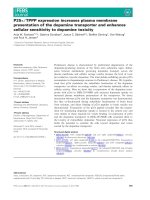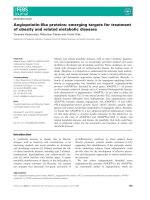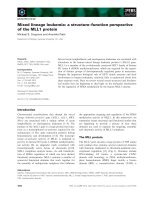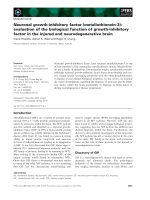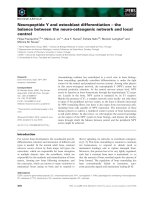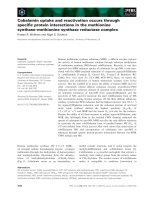Tài liệu Báo cáo khóa học: Active-site residues and amino acid specificity of the bacterial 4¢-phosphopantothenoylcysteine synthetase CoaB pptx
Bạn đang xem bản rút gọn của tài liệu. Xem và tải ngay bản đầy đủ của tài liệu tại đây (642.69 KB, 10 trang )
Active-site residues and amino acid specificity of the bacterial
4¢-phosphopantothenoylcysteine synthetase CoaB
Thomas Kupke
Lehrstuhl fu
¨
r Mikrobielle Genetik, Universita
¨
tTu
¨
bingen, Tu
¨
bingen, Germany
In bacteria, coenzyme A is synthesized in five steps from
D
-pantothenate. The Dfp flavoprotein catalyzes the synthe-
sis of the coenzyme A precursor 4¢-phosphopantetheine
from 4¢-phosphopantothenate and cysteine using the cofac-
tors CTP and flavine mononucleotide via the phospho-
peptide-like compound 4¢-phosphopantothenoylcysteine.
The synthesis of 4¢-phosphopantothenoylcysteine is cata-
lyzed by the C-terminal CoaB domain of Dfp and occurs via
the acyl-cytidylate intermediate 4¢-phosphopantothenoyl-
CMP in two half reactions. In this new study, the molecular
characterization of the CoaB domain is continued. In addi-
tion to the recently described residue Asn210, two more
active-site residues, Arg206 and Ala276, were identified
and shown to be involved in the second half reaction of
the (R)-4¢-phospho-N-pantothenoylcysteine synthetase. The
proposed intermediate of the (R)-4¢-phospho-N-panto-
thenoylcysteine synthetase reaction, 4¢-phosphopantothe-
noyl-CMP, was characterized by MALDI-TOF MS and it
was shown that the intermediate is copurified with the
mutant His-CoaB N210H/K proteins. Therefore, His-CoaB
N210H and His-CoaB N210K will be of interest to elucidate
the crystal structure of CoaB complexed with the reaction
intermediate. Wild-type His-CoaB is not absolutely specific
for cysteine and can couple derivatives of cysteine to
4¢-phosphopantothenate. However, no phosphopeptide-like
structure is formed with serine. Molecular characterization
of the temperature-sensitive Escherichia coli dfp-1 mutant
revealed that the residue adjacent to Ala276, Ala275 of the
strictly conserved AAVAD(275–279) motif, is exchanged
for Thr.
Keywords: coenzyme A biosynthesis; 4¢-phosphopantethe-
ine; 4¢-phosphopantothenoylcysteine synthetase; Dfp flavo-
protein; cysteine metabolism.
4¢-Phosphopantetheine (PP) coenzymes such as coen-
zyme A are the biochemically active forms of the vitamin
pantothenic acid. In coenzyme A, 4¢-phosphopantetheine
is covalently linked to an adenylyl group, whereas it is
covalently linked to a serine hydroxyl group in acyl carrier
proteins. 4¢-Phosphopantetheine is also cofactor of
enzymes that catalyze the biosynthesis of polypeptide
antibiotics [1]. Lipmann discovered and characterized
coenzyme A [2] and Lynen elucidated that the thiol
group of the cysteamine moiety of coenzyme A is the
functional group by activating substrates as thioesters [3].
In Escherichia coli and most eubacteria, the synthesis of
4¢-phosphopantetheine, which is also the key reaction in
coenzyme A biosynthesis, is catalyzed from 4¢-phospho-
pantothenate and cysteine by the bifunctional Dfp (CoaBC)
flavoproteins in a multistep process (Fig. 1; [4–7]). In the
first step, 4¢-phosphopantothenate is activated by reaction
with CTP. The 4¢-phosphopantothenoyl-cytidylate formed
is attacked by cysteine and 4¢-phosphopantothenoylcysteine
(PPC) is synthesized. These reactions occur at the
C-terminal CoaB domain of Dfp. The next step is the
FMN-dependent oxidative decarboxylation of PPC to
4¢-phosphopantothenoylaminoethenethiol, which is then
reduced to 4¢-phosphopantetheine; both partial reactions
are catalyzed by the N-terminal CoaC domain. Oxidative
decarboxylation of peptidyl-cysteines had already been
detected before as important step in the biosynthesis of the
lantibiotics epidermin and mersacidin catalyzed by the
LanD enzymes EpiD and MrsD, respectively [8–10]. Flavin-
dependent oxidative decarboxylation of PPC as an initial
step in the conversion of PPC to PP had been proposed by
Kupke et al. in 2000 [6] and was later confirmed for the
plant PPC decarboxylase AtHAL3a (AtCoaC) by purifying
oxidatively decarboxylated pantothenoylcysteine as a reac-
tion intermediate [11] and by determining the crystal
structure of AtHAL3a C175S complexed with this enethiol
intermediate [12]. Dfp, AtHAL3a, EpiD and MrsD belong
to a new family of flavoproteins that was named HFCD
(homo-oligomeric flavin-containing Cys decarboxylases)
[6,13].
In a recently published study [5], the PPC-synthetase
activity of the CoaB domain of Dfp was shown, a
dimerization motif within CoaB was proposed and the
strictly conserved residues N210 and K289 were prelimin-
ary investigated with respect to their ability to synthesize
PPC and the 4¢-phosphopantothenoyl-CMP intermediate.
Here, the molecular characterization of the bacterial PPC
Correspondence to T. Kupke, Lehrstuhl fu
¨
r Mikrobielle Genetik,
Universita
¨
tTu
¨
bingen, Auf der Morgenstelle 15, Verfu
¨
gungsgeba
¨
ude,
72076 Tu
¨
bingen, Germany.
Fax: + 49 7071 295937, Tel.: + 49 7071 2977608,
E-mail:
Abbreviations: His-CoaA, MRGSHHHHHHGSML-CoaA; His-
CoaB, MRGSHHHHHHG-Dfp S–R(181–406); IPTG, isopropyl
thio-b-
D
-galactoside; PP, 4¢-phosphopantetheine; PPC,
(R)-4¢-phospho-N-pantothenoylcysteine.
(Received 2 October 2003, accepted 11 November 2003)
Eur. J. Biochem. 271, 163–172 (2004) Ó FEBS 2003 doi:10.1046/j.1432-1033.2003.03916.x
synthetase activity is continued and focused on cysteine
binding by CoaB. In addition to residue N210, residues R206
and A276 are described as being important for conversion of
the 4¢-phosphopantothenoyl-CMP intermediate to the final
product PPC. Moreover, the 4¢-phosphopantothenoyl-CMP
intermediate was characterized by MALDI-TOF MS and
it is shown that the 4¢-phosphopantothenoyl-CMP inter-
mediate is copurified with His-CoaB N210H/K.
Dfp proteins were first purified and characterized as
flavoproteins by Spitzer and Weiss in the 1980s [14,15].
Although Spitzer et al. could not determine the enzymatic
functions of the Dfp proteins, they described the mutants
E. coli dfp-707 and E. coli dfp-1 that displayed temperature-
sensitive auxotrophy either for
D
-pantothenate or for its
precursor b-alanine. Molecular analysis of the conditional
lethality of the dfp-707 mutant revealed a single point
mutation within the N-terminal CoaC domain of Dfp [4]. In
this study, it is shown that in dfp-1 the residue Ala275 of the
conserved AAVAD(275–279) motif of the C-terminal CoaB
domain is exchanged for Thr.
Fig. 1. The role of Dfp (CoaBC) in 4¢-phosphopantothenoylcysteine and 4¢-phosphopantetheine biosynthesis. Coenzyme A is synthesized in five steps
from
D
-pantothenate. The bifunctional enzyme Dfp catalyzes the conversion of 4¢-phosphopantothenic acid to 4¢-phosphopantetheine via the
phosphopeptide-like compound 4¢-phosphopantothenoylcysteine, that is synthesized by the C-terminal CoaB domain from 4¢-phosphopantothenic
acid, CTP and cysteine. The synthesis of PPC occurs in two half reactions starting with the formation of 4¢-phosphopantothenoyl-CMP (activation
of the carboxyl group of 4¢-phosphopantothenate). In a second step, the amide bond of PPC (shaded in grey) is formed by reaction of
4¢-phosphopantothenoyl-CMP with cysteine. The PPC-decarboxylase activity resides in the N-terminal CoaC flavoprotein domain of Dfp. In a first
step, PPC is oxidatively decarboxylated to form 4¢-phosphopantothenoyl-aminoethenethiol, which is reduced in a second step to 4¢-phospho-
pantetheine, the final product of the enzymatic reaction catalyzed by the enzyme Dfp.
164 T. Kupke (Eur. J. Biochem. 271) Ó FEBS 2003
Materials and methods
Plasmid construction
In general, PCR amplifications were performed with Vent-
DNA-polymerase (New England Biolabs). The entire
sequences of the dfp and coaB coding regions of the
constructed plasmids were verified. Used oligonucleotides
were purchased from MWG Biotech.
Site-directed mutagenesis of coaB
All point mutations were first introduced into pQE12 dfp as
described recently by using sequential PCR and appropriate
mutagenesis primers [4]. Using the constructed mutant
pQE12 dfp plasmids as templates, the mutant coaB genes
were amplified and then cloned into pQE8 BamHI as
described [5].
Cloning and characterization of the
dfp
gene
from the
E. coli dfp-1
mutant
The temperature-sensitive mutant E. coli dfp-1 was grown
overnight in B-broth [10 g casein hydrolysate 140 (Gibco),
5 g yeast extract (Difco), 5 g NaCl, 1 g glucose, and
1gÆL
)1
K
2
HPO
4
, pH 7.3], at 30 °C and chromosomal
DNA was purified using the Qiagen Blood & Cell Cul-
ture DNA Mini Kit. For cloning, the mutant dfp gene
was amplified by PCR using the oligonucleotides,
(forward) 5¢-GCCAGTTTT
GAATTCTGGAAAGCGC
CTCG-3¢ and (reverse) 5¢-CGGGTCCA
AGATCTTAA
CGTCGATTTTTTTC-3¢ as primers (introduced EcoRI
and BglII sites are underlined) and the purified chromo-
somal DNA as template. The amplified gene was cloned
into pQE12 EcoRI/BglII and transformed in E. coli
M15 (pREP4) as described [4]. Using the pQE12 dfp-1
plasmid as template, the mutant coaB-1 gene was
amplified and then cloned into pQE8 BamHI as described
[5].
Purification and characterization of Dfp and CoaB
proteins
Growth of strains. E. coli M15 (pREP4, pQE8/pQE12)
cells were grown in the presence of ampicillin
(100 lgÆmL
)1
) and kanamycin (25 lgÆmL
)1
)in0.5Lof
B-broth in 2 L shaker flasks. At A
578
¼ 0.4, the cells were
induced with 1 m
M
isopropyl thio-b-
D
-galactoside (IPTG),
and harvested 2 h after induction. Growth temperature
was 37 °C.
Purification of His-CoaA and His-CoaB proteins
For purification of His-CoaA and His-CoaB proteins,
500 mL of IPTG-induced E. coli M15 (pREP4, pQE8
coaA/coaB) cells were harvested and disrupted by sonica-
tion in 10 mL 20 m
M
Tris/HCl (pH 8.0). 0.65–1.3 mL of
the cleared lysates obtained by two centrifugation steps
(each 20 min at 30 000 g at 4 °C) were applied to
Ni-nitrilotriacetic acid spin columns (Qiagen) equilibrated
with column buffer [20 m
M
Tris/HCl (pH 8.0), 10 m
M
imidazole, 300 m
M
NaCl]. The spin columns were then
washed twice with 0.65 mL column buffer. His-CoaA,
His-CoaB and mutant His-CoaB proteins were eluted
with 0.16 mL of column buffer containing 250 m
M
instead of 10 m
M
imidazole. The Ni-nitrilotriacetic acid
spin columns were centrifuged at room temperature at
only 240 g to enable effective binding of the His-tag
proteins.
Purification of Dfp and Dfp A275T (Dfp-1)
Five hundred milliliters of IPTG-induced E. coli M15
(pREP4, pQE-12 dfp) cells were harvested and disrupted
by sonication in 10 mL column buffer [20 m
M
Tris/HCl
(pH 8.0)]. Five milliliters of the cleared lysate obtained
by two centrifugation steps (each 25 min at 30 000 g at
4 °C) was diluted with 5 mL column buffer and loaded
on a 1 mL HiTrapQ column equilibrated with column
buffer. The column was then washed with 5 mL column
buffer and 5 mL column buffer containing 0.1
M
NaCl.
Dfp proteins were eluted with column buffer containing
0.25
M
NaCl and the yellow peak fractions (approxi-
mately 400 lL) were collected. A 25-lL aliquot of this
HiTrapQ eluate was then immediately subjected to a
Superdex 200 PC 3.2/30 gel filtration column equilibrated
in running buffer [20 m
M
Tris/HCl (pH 8.0), 200 m
M
NaCl] at a flow rate of 40 lLÆmin
)1
.Theelutionwas
followed by absorbance at 280, 378 and 450 nm.
Molecular mass information was obtained as described
[6], determining the elution volumes of standard proteins
and the void volume of the column. The Superdex 200
PC 3.2/30 column and the standard proteins used for
calibration were obtained from Amersham Pharmacia
Biotech.
CoaB assay
As 4¢-phosphopantothenate is not commercially available,
it was synthesized enzymatically in situ by adding
pantothenate kinase, His-CoaA,
D
-pantothenate and
ATP to the His-CoaB assay mixtures [5]. Therefore,
0.9 mL CoaB assay mixtures contained 5 m
MD
-panto-
thenate, 2.5 m
M
MgCl
2
,5m
M
ATP, 5 m
M
CTP, 5 m
M
cysteine hydrochloride, 5 m
M
dithhiothreitol, 100 m
M
Tris (pH 8.0) His-CoaA (approximately 10–15 lg) and
either wild-type or mutant His-CoaB proteins in the
range of 5–40 lg. After 30–45 min of incubation at
37 °C, the reaction mixtures were kept at )80 °C and
then were separated successively by reverse-phase chro-
matography with a lRPC C
2
/C
18
SC 2.1/10 column on a
SMART system (Pharmacia). Compounds were eluted
with a linear gradient of 0–50% acetonitrile/0.1%
trifluoroacetic acid in 5.8 mL, with a flow rate of
200 lLÆmin
)1
. The absorbance was measured simulta-
neously at 214, 260 and 280 nm to enable identification
of acyl-cytidylate intermediates.
SDS/PAGE
Purification of His-CoaB and Dfp proteins was examined
using tricine-SDS/PAGE (10%) under reducing conditions
[16]. Prestained protein molecular mass standards were
obtained from New England Biolabs.
Ó FEBS 2003 4¢-phosphopantothenoylcysteine synthetase CoaB (Eur. J. Biochem. 271) 165
Results and discussion
Characterization of the 4¢-phosphopantothenoyl-CMP
intermediate by MALDI-TOF MS
To confirm that the reaction intermediate of bacterial PPC
synthetases is indeed 4¢-phosphopantothenoyl-CMP, previ-
ous attempts to characterize the reaction intermediate by
mass spectrometry [5] were continued. The compound was
enzymatically synthesized in larger amounts, purified by
reversed phase chromatography and then analyzed by
MALDI-TOF mass spectrometry. In the mass spectrum
two prominent peaks with m/z values of 604.7 and 323.1
were present and are proposed to be 4¢-phospho-
pantothenoyl-CMP (theoretical monoisotopic mass of
[M + H]
+
¼ 605.1 Da) and CMP (theoretical monoiso-
topic mass of [M + H]
+
¼ 324.1), respectively (Fig. 2).
CMP was probably a by-product of 4¢-phosphopantothe-
noyl-CMP, although 4¢-phosphopantothenate was not
detected.
Molecular characterization of His-CoaB N210 mutants
The residue N210 of E. coli CoaB is strictly conserved in
bacterial and eukaryotic PPC synthetases (Fig. 3). To get
more information on its role in PPC synthesis, the recently
carried out study [5] was continued and further N210
mutants were analyzed (N210A/E/H/K/Q). All introduced
mutations drastically decreased the PPC synthetase activity
of His-CoaB but did not inhibit the formation of the
4¢-phosphopantothenoyl-CMP intermediate (data not
shown) confirming the recently obtained results for His-
CoaB N210D [5]. In contrast to His-CoaB N210D, the
mutant proteins N210H and N210K had no in vitro PPC
Fig. 2. Characterization of the 4¢-phospho-
pantothenoyl-CMP intermediate by MALDI-
TOF mass spectrometry. In vitro, enzymati-
cally, synthesized 4¢-phosphopantothenoyl-
CMP (A; peak labeled I) and CMP (B; 5 m
M
)
were separated by RPC. The elution from the
RPC column was followed by absorbance
at 280, 260 (not shown), and 214 nm (not
shown). CMP did not bind to the used lRPC
C
2
/C
18
SC 2.1/10 column and was found in the
flow-through. The 4¢-phosphopantothenoyl-
CMP containing fraction was subjected to
MALDI-TOF MS analysis (C).
166 T. Kupke (Eur. J. Biochem. 271) Ó FEBS 2003
synthesis activity at all (data not shown). From these results
it can be proposed that residue N210 is an active-site
residue. The mutant His-CoaB proteins N210A, N210E,
N210H, N210K and N210Q formed dimers as had also
been observed for the wt enzyme ([5]; Fig. 4).
Residues R206, N210 and A276 are involved in the
second half reaction of the PPC synthetase
Assuming that Asn210 is not the only residue of His-CoaB
that is important for the second-half reaction (and that is
probably involved in cysteine binding), the in vitro activity
of further mutants was measured in the presence and
absence of cysteine. It turned out that also for the mutant
proteins His-CoaB R206Q and His-CoaB A276V, the
4¢-phosphopantothenoyl-CMP intermediate but no or only
very little amounts of PPCaredetectableinpresenceof
cysteine (Fig. 5). Interestingly, the residues Arg206, Asn210
and Ala276 are not only conserved in bacterial Dfp/CoaB
proteins but also in eukaryotic PPC synthetases [5,17]. In
summary, it is proposed that Arg206, Asn210 and Ala276
are important for the second-half reaction and are part of
the active-site of CoaB; these residues may be directly
involved in binding of one of the substrates, the amino acid
cysteine (Fig. 3). However, it cannot be excluded that
cysteine binds to another site of CoaB and that exchanges of
the residues Arg206, Asn210 or Ala276 indirectly influence
the binding of cysteine to CoaB complexed with
4¢-phosphopantothenoyl-CMP.
Copurification of the 4¢-phosphopantothenoyl-CMP
intermediate
Taking into account that residues Arg206, Asn210 and
Ala276 are crucial for the second-half reaction of the
bacterial PPC synthetase activity, it was investigated
whether 4¢-phosphopantothenoyl-CMP is already bound
to mutant His-CoaB proteins purified by Ni-NTA chroma-
tography from E. coli cell extracts. No 4¢-phosphopanto-
thenoyl-CMP was copurified with wild-type His-CoaB or
His-CoaB K289Q (data not shown). However copurifica-
tion of low amounts of the intermediate was observed for
His-CoaB R206Q, His-CoaB N210D, and His-CoaB A276
(data not shown), whereas larger amounts of the inter-
mediate were copurified with His-CoaB N210H and
His-CoaB N210K (Fig. 4).
Ni-NTA purified protein His-CoaB N210K complexed
with the 4¢-phosphopantothenoyl-CMP intermediate was
incubated at 37 °C with 5 m
M
dithiothreitol and 5 m
M
L
-cysteine(inthepresenceof2.5m
M
MgCl
2
)andthen
analyzed by RPC to detect remaining 4¢-phosphopantothe-
noyl-CMP. Even after 60 min of incubation the amount of
4¢-phosphopantothenoyl-CMP only slightly decreased (data
not shown). Synthesis of 4¢-phosphopantothenoyl-CMP is
excluded in this experiment as 4¢-phosphopantothenate and
CTP were omitted. Therefore, only the occurrence of the
second-half reaction is investigated and it can be concluded
that either cysteine cannot bind to His-CoaB N210K-
4¢-phosphopantothenoyl-CMP or that the nucleophilic attack
on 4¢-phosphopantothenoyl-CMP by cysteine is inhibited.
PPC synthetase binds derivatives of cysteine
To study the substrate specificity of His-CoaB,
L
-serine,
L
-alanine, cysteamine,
L
-cysteine methyl ester, and
D
,
L
-homoserine were used as potential substrates. When
wild-type His-CoaB was used, the 4¢-phosphopantothenoyl-
CMP intermediate was converted to PPC (in presence
of cysteine) or to PP (in the presence of cysteamine) or
to 4¢-phosphopantothenoylcysteine methyl ester (in the
Fig. 3. Residues that are crucial for the second-half reaction are conserved in CoaB proteins. Residues of the N-terminal part of the Escherichia coli
CoaB domain that are conserved in CoaB (Dfp) proteins from all kingdoms of life and that were examined in the present study are in bold letters
[eubacteria, E. coli: P24285; archae, Metanocaldococcus jannaschii: Q58323; eukaryotes, human: XP_016228(gi:13638573) and yeast: P40506]. The
mutations R206Q, N210A/D/E/H/K/Q, A275T (dfp-1), A276V, D279E/N and K289Q are indicated by arrows; mutations influencing the second-
half reaction are underlined. The dimerization motif is slightly longer than has been determined in the first study ([5]; T. Kupke, unpublished data).
One reasonable explanation of the experimental data presented in this paper is that residues R206, N210 and A276 are involved directly in binding
the substrate amino acid cysteine. However, this model is in contrast to published data on the crystal structure of the human PPC synthetase [18].
Ó FEBS 2003 4¢-phosphopantothenoylcysteine synthetase CoaB (Eur. J. Biochem. 271) 167
presence of cysteine methyl ester). Although the structures
of PPand4¢-phosphopantothenoylcysteine methyl ester
reaction products were not confirmed by mass spectrome-
try, this conclusion can be made from the obtained HPLC
diagrams (data not shown). Wild-type His-CoaB was not
able to couple
L
-serine,
L
-alanine or
D
,
L
-homocysteine
to 4¢-phosphopantothenate, so that in these cases the
4¢-phosphopantothenoyl-CMP intermediate was still detect-
able. None of the compounds inhibited the formation of
4¢-phosphopantothenoyl-CMP or was coupled to 4¢-phos-
phopantothenate by His-CoaB N210D. These experiments
show that the PPC-synthetase CoaB is not absolutely
specific for
L
-cysteine, but can also bind derivatives of
cysteine, as long as the -CH
2
-SH side chain is not altered.
Fig. 4. Analysis of His-CoaB N210K and
copurification of the 4¢-phosphopantothenoyl-
CMP intermediate. His-CoaB proteins
(His-CoaB and His-CoaB N210K) were puri-
fied from E. coli cell extracts by Ni-nitrilotri-
acetic acid and either characterized by gel
filtration on a Superdex 200 PC 3.2/30 column
(A; [5]); using 20 m
M
Tris/HCl, pH 8.0/
200 m
M
NaCl as running buffer or separated
by RPC (B; approximately 150 lgofeach
protein were set in this case). The elution from
the columns was followed by absorbance at
280 nm (thick line) and absorbance at 260
(thin line) and 214 nm (not shown). From the
gel filtration column both proteins eluted at
approximately 1.56 mL (showing that both
proteins are dimers [5]). However, the proteins
differed significantly in their UV spectra.
Under the acidic conditions used in the RPC
experiment a compound bound to His-CoaB
N210K was removed and characterized by its
UV spectrum (B, right figure) and MALDI-
TOF mass spectrum (C) as 4¢-phosphopanto-
thenoyl-CMP.
168 T. Kupke (Eur. J. Biochem. 271) Ó FEBS 2003
The biochemical role of coenzyme A is the activation of
substrates by forming energy-rich thioester bonds. Oxo-
coenzyme A (which has an ethanolamine residue instead of
a cysteamine residue) cannot fulfill this role and may inhibit
cell growth. Therefore, the specificity of CoaB for the
incorporation of cysteine over serine is important. However,
it is very likely that also the PPC decarboxylase (CoaC)
activity and the 4¢-phosphopantetheine adenylyltransferase
activity contribute to the selectivity for cysteine. CoaC is
related to the flavoprotein EpiD that decarboxylates
peptidyl-cysteines but not peptidyl-serines [9] and it can be
proposed that CoaC cannot decarboxylate 4¢-phospho-
pantothenoylserine due to the mechanism of the decarb-
oxylation reaction [11,12].
Sequence analysis of the
E. coli
dfp-1 mutant
In 1985, Spitzer and Weiss described the dfp gene of E. coli
as a locus coding for a flavoprotein and affecting DNA
synthesis [15]. Later they showed that the conditional-lethal
dfp-707 mutation requires either
D
-pantothenate or
b-alanine for growth at 30 °C and that the dfp-1 mutation
conferred the auxotrophy but not the conditional lethality
of dfp-707. E. coli dfp-1 is unable to grow on a minimal
medium at 42 °C, but unlike dfp-707 is not temperature
sensitive for growth on rich media. Complementation
analysis suggested that the dfp-1 and dfp-707 mutations
were in the same gene [14]. The nutritional requirements of
the dfp-707 and dfp-1 mutants correspond to those of panD
mutants, however, dfp-mutants contained wild-type levels of
aspartate decarboxylase [14], which is required for synthesis
of b-alanine. Therefore it looks like, that an excess of
D
-pantothenate results in higher concentrations of 4¢-phos-
phopantothenate and that the partial blocking of the Dfp
(CoaBC) enzyme is overcome in this way.
The molecular basis for the conditional lethality of the
dfp-707 mutant is that one amino acid residue of the
N-terminal PPC decarboxylase (CoaC) domain of Dfp is
exchanged [4]. For further characterization of the dfp-1
mutation, the dfp-1 gene was cloned into pQE12, sequenced
and overexpressed. Sequence analysis revealed that dfp-1
has a point mutation in codon 275 of the dfp gene,
substituting the wild-type GCC (Ala) with ACC (Thr)
(Fig. 6); the G-A transition concurs with the use of
hydroxylamine as the mutagenic agent [14]. Therefore, the
dfp-1 mutation is within the AAVAD motif of the
C-terminal PPC synthetase (CoaB) domain of Dfp
(Fig. 3). In contrast to wild-type His-CoaB, His-CoaB
A275T is a monomeric protein, but Dfp and Dfp A275T are
both dodecameric proteins (Fig. 6); it was already shown
that also His-CoaB A275V is a monomeric protein [5]. The
molecular reason for the temperature sensitivity of the
E. coli dfp-1 mutant has to be elucidated in more detail, but
obviously increasing the temperature from 30 to 42 °C has
Fig. 5. Analysis of the enzymatic activity of His-CoaB R206Q and A276V. The synthesis of 4¢-phosphopantothenoyl-CMP (–cysteine, upper part of
the figure) and of 4¢-phosphopantothenoylcysteine (+ cysteine, lower part of the figure) by the mutant His-CoaB proteins R206Q and A276V was
analyzed using the described HPLC-based assay. The absorbance was monitored at 280 nm (left part of the figure), 214 nm (right part of the figure),
and 260 nm (not shown) to identify PPC and the 4¢-phosphopantothenoyl-CMP intermediate (peak labeled with I). As has already been observed
for the mutant N210 proteins, His-CoaB R206Q and A276V have very little PPC-synthetase activity and the 4¢-phosphopantothenoyl-CMP
intermediate is also detectable in the presence of cysteine. A minor portion of the detected 4¢-phosphopantothenoyl-CMP intermediate does not
result from de novo synthesis but has been copurified with the used His-CoaB proteins R206 and A276, respectively.
Ó FEBS 2003 4¢-phosphopantothenoylcysteine synthetase CoaB (Eur. J. Biochem. 271) 169
Fig. 6. The temperature-sensitive mutant E. coli dfp-1. (A) dfp-1 was cloned into pQE12 and sequence analysis revealed a single point mutation
within the AAVAD motif of CoaB proteins, namely Ala275 is exchanged for Thr275. (B) Dfp and Dfp A275T (¼ Dfp-1) were enriched by anionic
exchange chromatography and then purified by gel filtration chromatography from the overexpressing E. coli strains grown at 37 °C.Theelution
from the Supderdex 200 PC 3.2/30 gel filtration column was followed by absorbance at 280 (upper line), 378 (not shown), and 450 nm (lower line).
Both wild-type and Dfp A275T proteins (peak labeled with asterisks) eluted at about 1.04 mL and bound flavin coenzyme, as shown by absorbance
at 450 nm. The corresponding His-CoaB proteins were purified by IMAC from the overexpressing E. coli strains grown at 37 °C (same results were
obtained when cells were grown at 28 °C). In contrast to the Dfp proteins, the His-CoaB proteins showed different elution volumes in the gel
filtration experiments indicating that His-CoaB A275T is a monomeric enzyme.
170 T. Kupke (Eur. J. Biochem. 271) Ó FEBS 2003
an effect on 4¢-phosphopantetheine and coenzyme A
biosynthesis. With the used assay, it is difficult to evaluate
the PPC synthetase activity at different temperatures,
because the enzymatic activity of the present pantothenate
kinase (used for in situ synthesis of 4¢-phosphopantothe-
nate) is also temperature-dependent. However, increasing
the temperature from 30 to 42 °C significantly increases the
detectable amounts of PPC when wt His-CoaB is used,
whereas there is a slight decrease for His-CoaB A275T (data
not shown). As has been determined above, the residue
adjacent to Ala275, Ala276, is an active-site residue
probably involved in binding the substrate cysteine. There-
fore, it is assumed that Ala275 is also an active-site residue
of E. coli CoaB. The observed PPC synthetase activity of
His-CoaB A275T shows that dimerization of CoaB is not
essential for activity.
Comparison of site-directed mutagenesis studies
with structure of human PPC synthetase
Recently, the structure of the ATP-dependent human
phosphopantothenoylcysteine synthetase was determined
at 2.3-A
˚
resolution [18]. This enzyme is a dimer from
identical monomers with the monomer fold having features
in common with a group of NAD-dependent enzymes on
one hand and with the ribokinase fold on the other hand.
The structure of the human PPC synthetase complexed with
substrates, the cosubstrate ATP or the intermediate 4¢-phos-
phopantothenoyl-AMP was not experimentally determined
by Manoj et al [18]. However, models for the 4¢-phospho-
pantothenate and ATP binding sites were reported. From
these models, the conserved ATP binding residues Gly43,
Ser61, Gly63, Gly66, Phe230, and Asn258 were identified in
human CoaB. The identified 4¢-phosphopantothenate bind-
ing residues Asn59, Ala179, Ala180 and Asp183 from one
monomer and Arg55¢ from the adjacent monomer corres-
pond to E. coli CoaB residues Asn210, Ala275, Ala276,
Asp279 and Arg206. A model of human CoaB containing
simultaneously bound 4¢-phosphopantothenoyl-AMP and
cysteine was not reported. The strictly conserved lysine
residue Lys195 of human CoaB (corresponding to Lys289
of E. coli CoaB) is located in a disordered loop. As this
lysine residue has been identified as an active-site residue [5],
it is tempting to speculate that the loop is involved in
binding one of the (co)substrates of CoaB, indicating that
the provided models of the substrate binding sites of human
CoaB do not give a complete insight into the active-site
architecture of CoaB. The data obtained from the presented
mutagenesis studies indicate that residues Arg206, Asn210
and Ala276 are important for the conversion of
4¢-phosphopantothenoyl-CMP to PPC and are not crucial
for binding 4¢-phosphopantothenate (or CTP; Fig. 3). The
mutant proteins CoaB A275T, CoaB D279N, and CoaB
D279E (data not shown) were able to synthesize
4¢-phosphopantothenoylcysteine and the 4¢-phosphopanto-
thenoyl-CMP intermediate was not detectable anymore
when cysteine was present in the assay. This indicates that
the five residues proposed by Manoj et al. to be involved in
4¢-phosphopantothenate binding are not functionally equiv-
alent, at least in the E. coli protein.
In order to assign a function to the conserved lysine
residue and to all the other conserved CoaB residues, it
will be extremely important to obtain not only models
but also crystal structures of both the human and the
bacterial CoaB proteins complexed with the (co)substrates
and, most importantly, a structure of a CoaB mutant in
complex with the 4¢-phosphopantothenoyl-C(A)MP inter-
mediate (and cysteine). A structure of CoaB N210H/K in
complex with 4¢-phosphopantothenoyl-CMP (and pos-
sibly cysteine) will be indispensable to explain the
experimental data presented in this paper. These crystal
structures will also be important to answer the question
why bacterial CoaB is specific for CTP, whereas human
CoaB utilizes ATP four times more efficiently than
CTP [19].
Conclusions
In this study, active-site residues of E. coli CoaB were
identified that are involved in the second half reaction of the
PPC synthetase. It was demonstrated that the 4¢-phospho-
pantothenoyl-CMP intermediate is copurified with mutant
His-CoaB N210 proteins. This observation can enable
crystal structure analysis of PPC synthetases complexed
with the reaction intermediate. Copurification of the
4¢-phosphopantothenoyl-CMP intermediate with mutant
CoaB proteins also shows that the in vivo function of CoaB
is the synthesis of PPC.
Studying Dfp is of great general biochemical interest, as it
is this enzyme that links cysteine metabolism with the
biosynthesis of coenzyme A. It has also been discussed that
Dfp is an interesting target for the development of new
antibacterials [7,18–20]. Antibacterials have already been
developed against staphylococcal pantothenate kinase [21]
and the bacterial phosphopantetheine adenylyltransferase
activity [22].
Acknowledgements
I thank Regine Stemmler for excellent technical assistance, Bernard
Weiss for providing the E. coli dfp-1 mutant and Stefan Stevanovic for
MALDI-TOF MS experiments. This work was supported by Deutsche
Forschungsgemeinschaft research grant KU869/6–1 and research
fellowship KU 869/9–1 to TK.
References
1. Kleinkauf, H. (2000) The role of 4¢-phosphopantetheine in the
biosynthesis of fatty acids, polyketides and peptides. Biofactors 11,
91–92.
2. Lipmann, F. (1942–62) Development of the acetylation problem:
a personal account in Nobel lectures: Physiology or Medicine,
pp. 413–438, American Elsevier, New York.
3. Lynen, F. (1963–70) The Pathway from ‘Activated Acetic Acid’ to
the Terpenes and Fatty Acids in Nobel Lectures: Physiology or
Medicine, pp. 103–138, American Elsevier, New York.
4. Kupke, T. (2001) Molecular characterization of the 4¢-phospho-
pantothenoylcysteine decarboxylase domain of bacterial Dfp
flavoproteins. J. Biol. Chem. 276, 27597–27604.
5. Kupke, T. (2002) Molecular characterization of the 4¢-phospho-
pantothenoylcysteine synthetase domain of bacterial Dfp flavo-
proteins. J. Biol. Chem. 277, 36137–36145.
6. Kupke, T., Uebele, M., Schmid, D., Jung, G., Blaesse, M. &
Steinbacher, S. (2000) Molecular characterization of lantibiotic-
synthesizing enzyme EpiD reveals a function for bacterial Dfp
Ó FEBS 2003 4¢-phosphopantothenoylcysteine synthetase CoaB (Eur. J. Biochem. 271) 171
proteins in coenzyme A biosynthesis. J. Biol. Chem. 275, 31838–
31846.
7. Strauss, E., Kinsland, C., Ge, Y., McLafferty, F.W. & Begley, T.P.
(2001) Phosphopantothenoylcysteine synthetase from Escherichia
coli: Identification and characterization of the last unidentified
coenzyme A biosynthetic enzyme in bacteria. J. Biol. Chem. 276,
13513–13516.
8. Kupke,T.,Kempter,C.,Gnau,V.,Jung,G.&Go
¨
tz, F. (1994)
Mass spectroscopic analysis of a novel enzymatic reaction:
oxidative decarboxylation of the lantibiotic precursor peptide
EpiA catalyzed by the flavoprotein EpiD. J. Biol. Chem. 269,
5653–5659.
9. Kupke,T.,Kempter,C.,Jung,G.&Go
¨
tz, F. (1995) Oxidative
decarboxylation of peptides catalyzed by flavoprotein EpiD:
determination of substrate specificity using peptide libraries
and neutral loss mass spectrometry. J. Biol. Chem. 270, 11282–
11289.
10. Majer, F., Schmid, D.G., Altena, K., Bierbaum, G. & Kupke, T.
(2002) The flavoprotein MrsD catalyzes the oxidative decarbox-
ylation reaction involved in formation of the peptidoglycan
biosynthesis inhibitor mersacidin. J. Bacteriol. 184, 1234–1243.
11. Herna
´
ndez-Acosta, P., Schmid, D.G., Jung, G., Culia
´
n
˜
ez-Macia
`
,
F.A. & Kupke, T. (2002) Molecular characterization of the
Arabidopsis thaliana flavoprotein AtHAL3a reveals the general
reaction mechanism of 4¢-phosphopantothenoylcysteine decarb-
oxylases. J. Biol. Chem. 277, 20490–20498.
12. Steinbacher, S., Herna
´
ndez-Acosta, P., Bieseler, B., Blaesse, M.,
Huber, R., Culia
´
n
˜
ez-Macia
`
, F.A. & Kupke, T. (2003) Crystal
structure of the plant PPC decarboxylase AtHAL3a complexed
with an ene-thiol reaction intermediate. J. Mol. Biol. 327, 193–202.
13. Blaesse, M., Kupke, T., Huber, R. & Steinbacher, S. (2000)
Crystal structure of the peptidyl-cysteine decarboxylase EpiD
complexed with a pentapeptide substrate. EMBO J. 19, 6299–
6310.
14. Spitzer, E.D., Jimenez-Billini, H.E. & Weiss, B. (1988) b-Alanine
auxotrophy associated with dfp, a locus affecting DNA synthesis
in Escherichia coli. J. Bacteriol. 170, 872–876.
15. Spitzer, E.D. & Weiss, B. (1985) dfp gene of Escherichia coli K-12,
a locus affecting DNA synthesis, codes for a flavoprotein.
J. Bacteriol. 164, 994–1003.
16. Scha
¨
gger, H. & Jagow, G. (1987) Tricine-sodium dodecyl sulfate-
polyacrylamide gel electrophoresis for the separation of proteins in
the range from 1 to 100 kDa. Anal. Biochem. 166, 368–379.
17. Kupke, T., Herna
´
ndez-Acosta, P. & Culia
´
n
˜
ez-Macia
`
, F.A. (2003)
4¢-Phosphopantetheine and coenzyme A biosynthesis in plants.
J. Biol. Chem. 278, 38229–38237.
18. Manoj, N., Strauss, E., Begley, T.P. & Ealick, S.E. (2003) Struc-
ture of human phosphopantothenoylcysteine synthetase at 2.3 A
˚
resolution. Structure (Camb). 11, 927–936.
19. Daugherty, M., Polanuyer, B., Farrell, M., Scholle, M., Lykidis,
A., De Cre
´
cy-Lagard, V. & Osterman, A. (2002) Complete
reconstitution of the human coenzyme A biosynthetic pathway via
comparative genomics. J. Biol. Chem. 277, 21431–21439.
20. Gerdes, S.Y., Scholle, M.D., D’Souza, M., Bernal, A., Baev,
M.V.,Farrell,M.,Kurnasov,O.V.,Daugherty,M.D.,Mseeh,F.,
Polanuyer, B.M., Campbell, J.W., Anantha, S., Shatalin, K.Y.,
Chowdhury,S.A.,Fonstein,M.Y.&Osterman,A.L.(2002)From
genetic footprinting to antimicrobial drug targets: examples in
cofactor biosynthetic pathways. J. Bacteriol. 184, 4555–4572.
21. Choudhry, A.E., Mandichak, T.L., Broskey, J.P., Egolf, R.W.,
Kinsland, C., Begley, T.P., Seefeld, M.A., Ku, T.W., Brown, J.R.,
Zalacain, M. & Ratnam, K. (2003) Inhibitors of pantothenate
kinase: novel antibiotics for Staphylococcalinfections. Antimicrob.
Agents Chemother. 47, 2051–2055.
22. Zhao, L., Allanson, N.M., Thomson, S.P., Maclean, J.K., Barker,
J.J.,Primrose,W.U.,Tyler,P.D.&Lewendon,A.(2003)
Inhibitors of phosphopantetheine adenylyltransferase. Eur. J.
Med. Chem. 38, 345–349.
172 T. Kupke (Eur. J. Biochem. 271) Ó FEBS 2003

